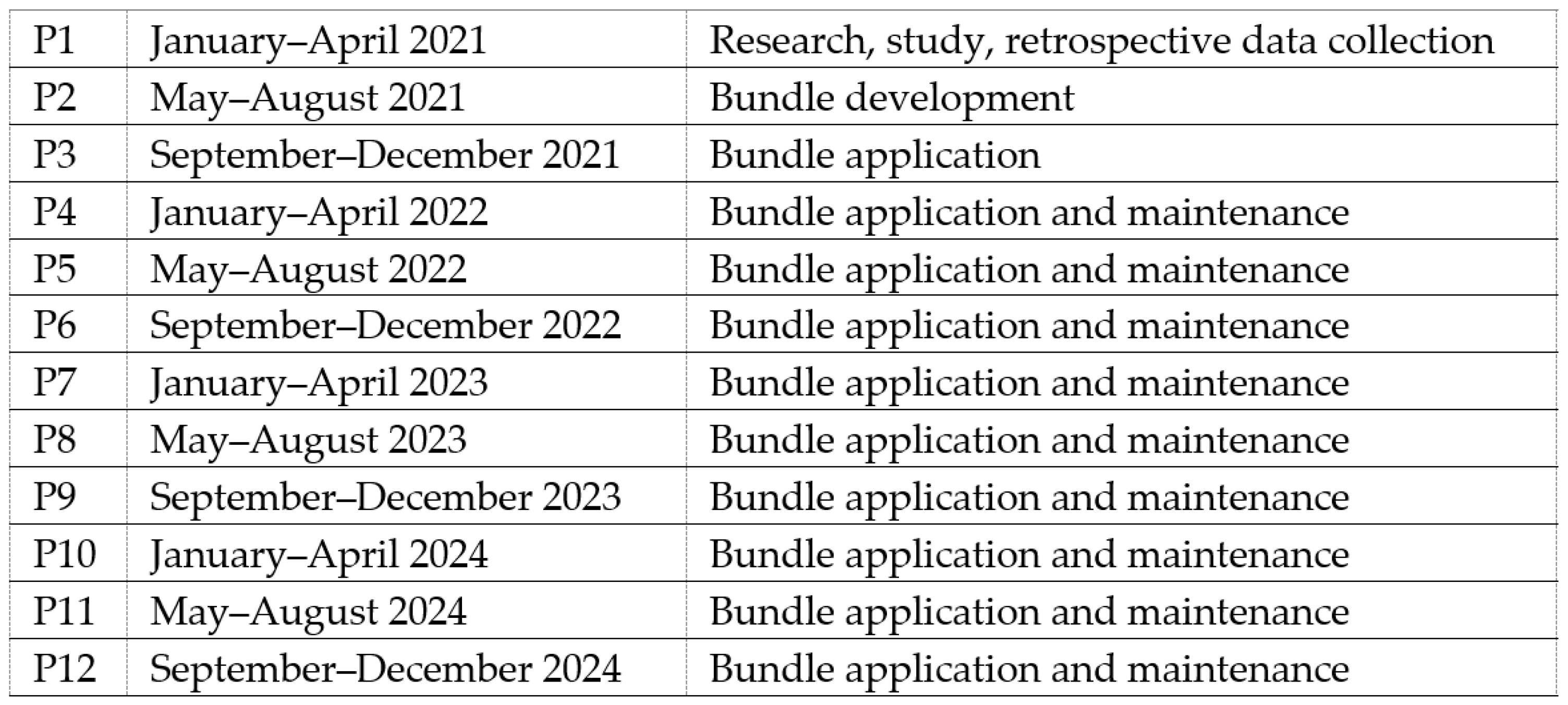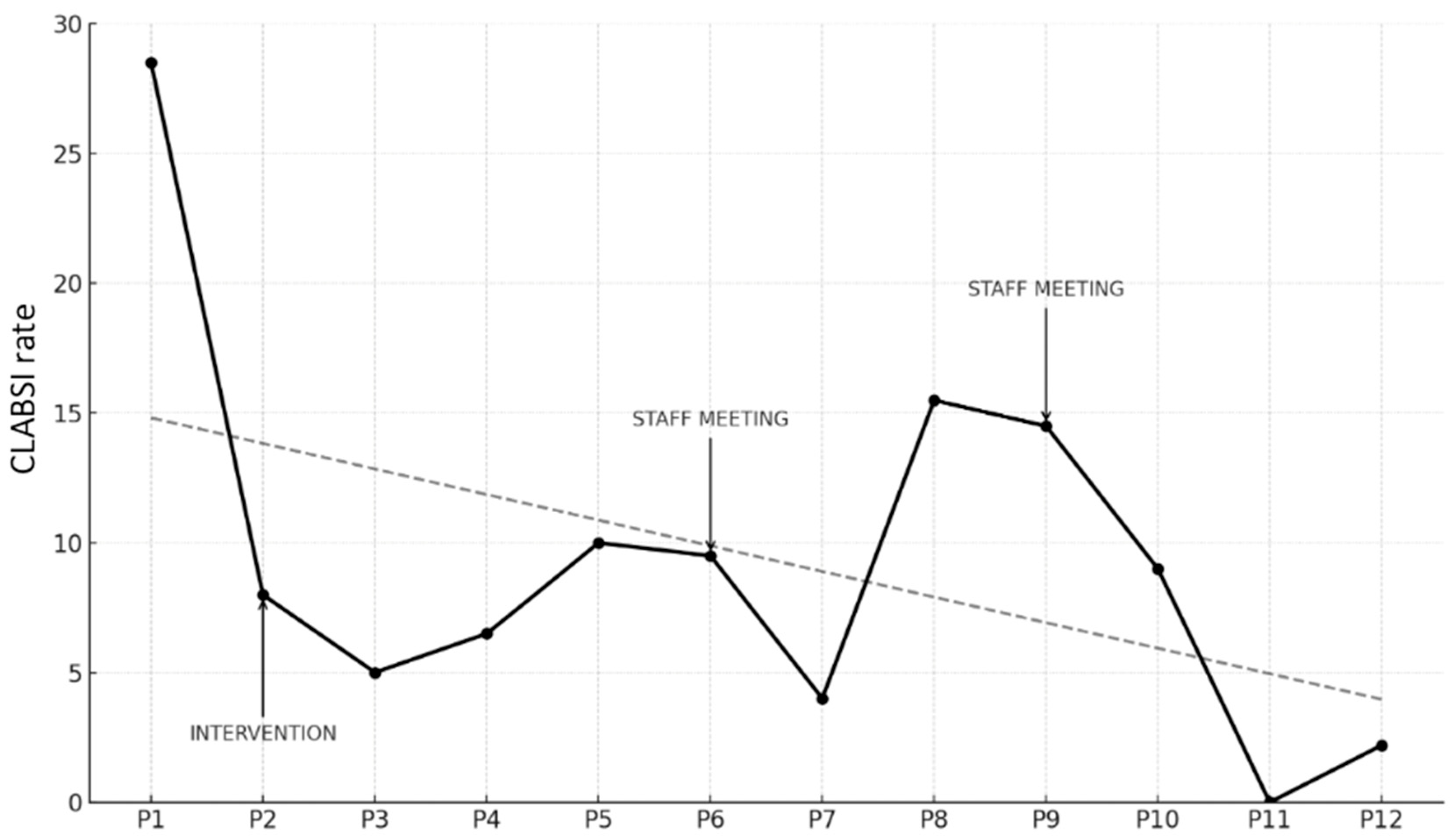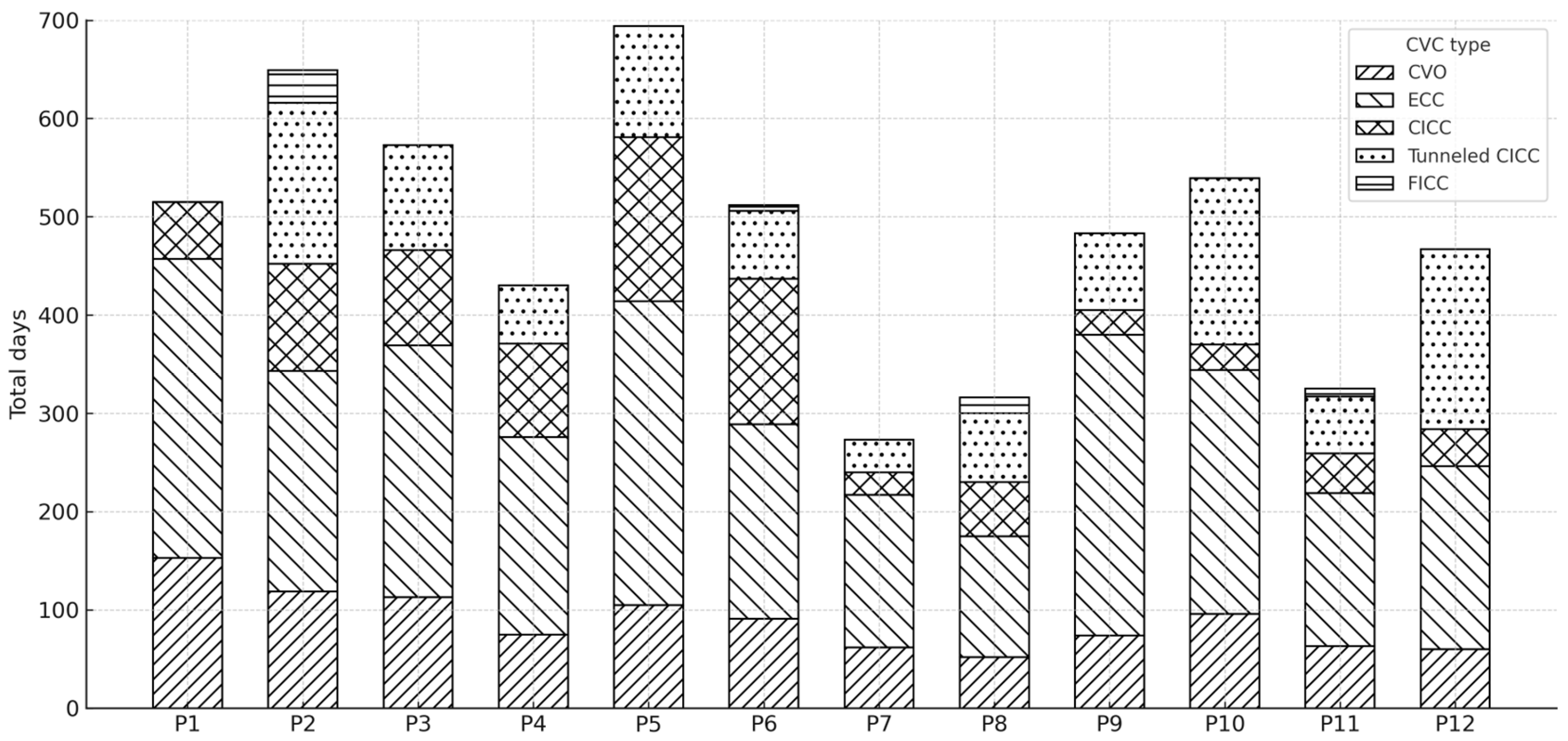Impact of an Evidence-Based Bundle on Catheter-Associated Sepsis Incidence in Neonatal Intensive Care: A Quality Improvement Project
Abstract
1. Introduction
2. Materials and Methods
2.1. Study Design and Population
- Perform meticulous mapping of all superficial veins following the RaSuVA (Rapid Superficial Vein Assessment) protocol [14].
- Estimate the required catheter length to reach the superior or inferior vena cava.
- Proper hand hygiene.
- Use full barrier precautions, including sterile gloves, sterile gown, non-sterile cap, non-sterile mask, and comprehensive sterile draping of the patient.
- Achieve maximum stabilization of the venous access to prevent dislodgment, minimize catheter movement at the exit site, minimizing further manipulations at the insertion site and reducing the risk of infection and thrombosis. The stabilization strategies include:
- Sutureless fixation device: Provides secure and atraumatic stabilization.
- Transparent, semipermeable, high-breathability polyurethane dressing: fully isolates the catheter’s exit site, serving as a mechanical barrier while allowing direct visualization [20]. Its high breathability ensures adequate skin ventilation, preventing maceration.
- The indication for CVC use should be reassessed daily, and the catheter should be removed within 24 h if no longer deemed necessary.
- The insertion site should be inspected daily for signs of infection; if infection is suspected, the CVC should be removed within 24 h.
2.2. Outcomes
2.3. Sample Size
2.4. Statistical Analysis
2.5. Ethical Considerations
3. Results
3.1. Description of the Population
3.2. CLABSI Rate
3.3. Usage and Type of Catheter
3.4. Microbiological Aspects
4. Discussion
5. Conclusions
Author Contributions
Funding
Institutional Review Board Statement
Informed Consent Statement
Data Availability Statement
Conflicts of Interest
References
- Polin, R.A.; Denson, S.; Brady, M.T.; Committee on Fetus and Newborn; Committee on Infectious Diseases; Papile, L.-A.; Baley, J.E.; Carlo, W.A.; Cummings, J.J.; Kumar, P.; et al. Epidemiology and Diagnosis of Health Care-Associated Infections in the NICU. Pediatrics 2012, 129, e1104–e1109. [Google Scholar] [CrossRef]
- Payne, N.R.; Carpenter, J.H.; Badger, G.J.; Horbar, J.D.; Rogowski, J. Marginal Increase in Cost and Excess Length of Stay Associated with Nosocomial Bloodstream Infections in Surviving Very Low Birth Weight Infants. Pediatrics 2004, 114, 348–355. [Google Scholar] [CrossRef]
- De Cicco, M.; Campisi, C.; Matovic, M. Central Venous Catheter-Related Bloodstream Infections: Pathogenesis Factors, New Perspectives in Prevention and Early Diagnosis. J. Vasc. Access 2003, 4, 83–91. [Google Scholar] [CrossRef]
- Zipursky, A.R.; Yoon, E.W.; Emberley, J.; Bertelle, V.; Kanungo, J.; Lee, S.K.; Shah, P.S.; Canadian Neonatal Network Investigators. Central Line-Associated Blood Stream Infections and Non-Central Line-Associated Blood Stream Infections Surveillance in Canadian Tertiary Care Neonatal Intensive Care Units. J. Pediatr. 2019, 208, 176–182.e6. [Google Scholar] [CrossRef] [PubMed]
- Rupp, M.E.; Karnatak, R. Intravascular Catheter-Related Bloodstream Infections. Infect. Dis. Clin. 2018, 32, 765–787. [Google Scholar] [CrossRef] [PubMed]
- CDC Prevention and Control of Infections in Neonatal Intensive Care Unit Patients: Central Line-Associated Blood Stream Infections. Available online: https://www.cdc.gov/infection-control/hcp/nicu-clabsi/index.html (accessed on 1 September 2024).
- Piazza, A.J.; Brozanski, B.; Provost, L.; Grover, T.R.; Chuo, J.; Smith, J.R.; Mingrone, T.; Moran, S.; Morelli, L.; Zaniletti, I.; et al. SLUG Bug: Quality Improvement with Orchestrated Testing Leads to NICU CLABSI Reduction. Pediatrics 2016, 137, e20143642. [Google Scholar] [CrossRef]
- Bierlaire, S.; Danhaive, O.; Carkeek, K.; Piersigilli, F. How to Minimize Central Line–Associated Bloodstream Infections in a Neonatal Intensive Care Unit: A Quality Improvement Intervention Based on a Retrospective Analysis and the Adoption of an Evidence-Based Bundle. Eur. J. Pediatr. 2021, 180, 449–460. [Google Scholar] [CrossRef]
- Rosenthal, V.D.; Dueñas, L.; Sobreyra-Oropeza, M.; Ammar, K.; Navoa-Ng, J.A.; de Casares, A.C.B.; de Machuca, L.J.; Ben-Jaballah, N.; Hamdi, A.; Villanueva, V.D.; et al. Findings of the International NosocomialInfection Control Consortium (INICC), Part III Effectiveness of a Multidimensional Infection Control Approach to Reduce Central Line—Associated Bloodstream Infections in the Neonatal Intensive Care Units of 4 Developing Countries. Infect. Control Hosp. Epidemiol. 2013, 34, 229–237. [Google Scholar] [CrossRef]
- Pronovost, P.; Needham, D.; Berenholtz, S.; Sinopoli, D.; Chu, H.; Cosgrove, S.; Sexton, B.; Hyzy, R.; Welsh, R.; Roth, G.; et al. An Intervention to Decrease Catheter-Related Bloodstream Infections in the ICU. N. Engl. J. Med. 2006, 355, 2725–2732. [Google Scholar] [CrossRef]
- Raccomandazioni GAVeCeLT 2024|GAVeCeLT. Available online: https://gavecelt.it/nuovo/biblioteca/raccomandazioni-gavecelt-2024 (accessed on 29 September 2025).
- Payne, V.; Hall, M.; Prieto, J.; Johnson, M. Care Bundles to Reduce Central Line-Associated Bloodstream Infections in the Neonatal Unit: A Systematic Review and Meta-Analysis. Arch. Dis. Child.-Fetal Neonatal Ed. 2018, 103, F422–F429. [Google Scholar] [CrossRef]
- Miller, M.R.; Griswold, M.; Harris, J.M.; Yenokyan, G.; Huskins, W.C.; Moss, M.; Rice, T.B.; Ridling, D.; Campbell, D.; Margolis, P.; et al. Decreasing PICU Catheter-Associated Bloodstream Infections: NACHRI’s Quality Transformation Efforts. Pediatrics 2010, 125, 206–213. [Google Scholar] [CrossRef] [PubMed]
- D’Andrea, V.; Prontera, G.; Pezza, L.; Barone, G.; Vento, G.; Pittiruti, M. Rapid Superficial Vein Assessment (RaSuVA): A Pre-Procedural Systematic Evaluation of Superficial Veins to Optimize Venous Catheterization in Neonates. J. Vasc. Access 2024, 25, 303–307. [Google Scholar] [CrossRef] [PubMed]
- Mimoz, O.; Lucet, J.-C.; Kerforne, T.; Pascal, J.; Souweine, B.; Goudet, V.; Mercat, A.; Bouadma, L.; Lasocki, S.; Alfandari, S.; et al. Skin Antisepsis with Chlorhexidine-Alcohol Versus PovidoneIodine-Alcohol, With and Without Skin Scrubbing, for Prevention of Intravascular-Catheter-Related Infection (CLEAN): An Open-Label, Multicentre, Randomised, Controlled, Two-by-Two Factorial Trial. Lancet 2015, 386, 2069–2077. [Google Scholar] [CrossRef]
- Hibbard, J.S.; Mulberry, G.K.; Brady, A.R. A Clinical Study Comparing the Skin Antisepsis and Safety of ChloraPrep, 70% Isopropyl Alcohol, and 2% Aqueous Chlorhexidine. J. Infus. Nurs. 2002, 25, 244–249. [Google Scholar] [CrossRef]
- D’Andrea, V.; Pezza, L.; Barone, G.; Prontera, G.; Pittiruti, M.; Vento, G. Use of Cyanoacrylate Glue for the Sutureless Securement of Epicutaneo-Caval Catheters in Neonates. J. Vasc. Access 2022, 23, 801–804. [Google Scholar] [CrossRef]
- Piersigilli, F.; Iacona, G.; Yazami, S.; Carkeek, K.; Hocq, C.; Auriti, C.; Danhaive, O. Cyanoacrylate Glueas Part of a New Bundle to Decrease Neonatal PICC-Related Complications. Eur. J. Pediatr. 2023, 182, 5607–5613. [Google Scholar] [CrossRef]
- Scoppettuolo, G.; Dolcetti, L.; Emoli, A.; La Greca, A.; Biasucci, D.G.; Pittiruti, M. Further Benefits of Cyanoacrylate Glue for Central Venous Catheterisation. Anaesthesia 2015, 70, 758. [Google Scholar] [CrossRef]
- Pittiruti, M.; Celentano, D.; Barone, G.; D’Andrea, V.; Annetta, M.G.; Conti, G. A GAVeCeLT Bundle for Central Venous Catheterization in Neonates and Children: A Prospective Clinical Study on 729 Cases. J. Vasc. Access 2023, 24, 1477–1488. [Google Scholar] [CrossRef]
- Taylor, M.J.; McNicholas, C.; Nicolay, C.; Darzi, A.; Bell, D.; Reed, J.E. Systematic Review of the Application of the Plan–Do–Study–Act Method to Improve Quality in Healthcare. BMJ Qual. Saf. 2014, 23, 290–298. [Google Scholar] [CrossRef] [PubMed]
- Horan, T.C.; Andrus, M.; Dudeck, M.A. CDC/NHSN Surveillance Definition of Health Care-Associated Infection and Criteria for Specific Types of Infections in the Acute Care Setting. Am. J. Infect. Control 2008, 36, 309–332. [Google Scholar] [CrossRef]
- Jakobsen, J.C.; Gluud, C.; Wetterslev, J.; Winkel, P. When and How Should Multiple Imputation Be Used for Handling Missing Data in Randomised Clinical Trials—A Practical Guide with Flowcharts. BMC Med. Res. Methodol. 2017, 17, 162. [Google Scholar] [CrossRef]
- Umscheid, C.A.; Mitchell, M.D.; Doshi, J.A.; Agarwal, R.; Williams, K.; Brennan, P.J. Estimating the Proportion of Healthcare-Associated Infections That Are Reasonably Preventable and the Related Mortality and Costs. Infect. Control. Hosp. Epidemiol. 2011, 32, 101–114. [Google Scholar] [CrossRef] [PubMed]
- Schmid, S.; Geffers, C.; Wagenpfeil, G.; Simon, A. Preventive Bundles to Reduce Catheter-Associated Bloodstream Infections in Neonatal Intensive Care. GMS Hyg. Infect. Control 2018, 13, Doc10. [Google Scholar] [CrossRef] [PubMed]
- Sinha, A.K.; Murthy, V.; Nath, P.; Morris, J.K.; Millar, M. Prevention of Late Onset Sepsis and Central-Line Associated Blood Stream Infection in Preterm Infants. Pediatr. J. 2016, 35, 401–406. [Google Scholar] [CrossRef] [PubMed]
- Resende, D.S.; Brito, D.D.; Abdallah, V.O.; Filho, P.P.G. Reduction of Catheter-Associated Bloodstream Infections Through Procedures in Newborn Babies Admittedin a University Hospital Intensive Care Unit in Brazil. Rev. Soc. Bras. Med. Trop. 2011, 44, 731–734. [Google Scholar] [CrossRef]
- Mobley, R.E.; Bizzarro, M.J. Central Line-Associated Bloodstream Infections in the NICU: Successes and Controversies in the Quest for Zero. Semin. Perinatol. 2017, 41, 166–174. [Google Scholar] [CrossRef]
- Coggins, S.A.; Glaser, K. Updates in Late-Onset Sepsis: Risk Assessment, Therapy and Outcomes. Neoreviews 2022, 23, 738–755. [Google Scholar] [CrossRef]
- Boghossian, N.S.; Page, G.P.; Bell, E.F.; Stoll, B.J.; Murray, J.C.; Cotten, C.M.; Shankaran, S.; Walsh, M.C.; Laptook, A.R.; Newman, N.S.; et al. Late-Onset Sepsis in Very Low Birth Weight Infants from Singleton and Multiple-Gestation Births. J. Pediatr. 2013, 162, 1120–1124.e1. [Google Scholar] [CrossRef]
- Greenberg, R.G.; Kandefer, S.; Do, B.T.; Smith, P.B.; Stoll, B.J.; Bell, E.F.; Carlo, W.A.; Laptook, A.R.; Sánchez, P.J.; Shankaran, S.; et al. Late-Onset Sepsis in Extremely Premature Infants: 2000–2011. Pediatr. J. 2017, 36, 774–779. [Google Scholar] [CrossRef]
- Rosado, V.; Camargos, P.A.M.; Anchieta, L.M.; Bouzada, M.C.F.; de Oliveira, G.M.; Clemente, W.T.; de Romanelli, R.M.C. Risk Factors for Central Venous Catheter-Related Infectionsin aNeonatal Population—Systematic Review. J. Pediatr. 2018, 94, 3–14. [Google Scholar] [CrossRef]
- Barone, G.; D’Andrea, V.; Ancora, G.; Cresi, F.; Maggio, L.; Capasso, A.; Mastroianni, R.; Pozzi, N.; Rodriguez-Perez, C.; Romitti, M.G.; et al. The Neonatal DAV-Expert Algorithm: A GAVeCeLT/GAVePed Consensus for the Choice of the Most Appropriate Venous Access in Newborns. Eur. J. Pediatr. 2023, 182, 3385–3395. [Google Scholar] [CrossRef]
- Lafuente Cabrero, E.; Terradas Robledo, R.; Civit Cuñado, A.; García Sardelli, D.; Hidalgo López, C.; Giro Formatger, D.; Lacueva Perez, L.; Esquinas López, C.; Tortosa Moreno, A. Risk Factors of Catheter- Associated Bloodstream Infection: Systematic Review and Meta-Analysis. PLoS ONE 2023, 18, e0282290. [Google Scholar] [CrossRef] [PubMed]
- Catho, G.; Rosa Mangeret, F.; Sauvan, V.; Chraïti, M.-N.; Pfister, R.; Baud, O.; Harbarth, S.; Buetti, N. Risk of Catheter-Associated Bloodstream Infection by Catheter Type in a Neonatal Intensive Care Unit: A Large Cohort Study of More than 1100 IntravascularCatheters. J. Hosp. Infect. 2023, 139, 6–10. [Google Scholar] [CrossRef] [PubMed]
- Cheng, H.-Y.; Lu, C.-Y.; Huang, L.-M.; Lee, P.-I.; Chen, J.-M.; Chang, L.-Y. Increased Frequency of Peripheral Venipunctures Raises the Risk of Central-Line Associated Bloodstream Infection in Neonates with Peripherally Inserted Central Venous Catheters. J. Microbiol. Immunol. Infect. 2016, 49, 230–236. [Google Scholar] [CrossRef] [PubMed]
- Blanchard, A.C.; Fortin, E.; Rocher, I.; Moore, D.L.; Frenette, C.; Tremblay, C.; Quach, C. Central Line–Associated Bloodstream Infection in Neonatal Intensive Care Units. Infect. Control Hosp. Epidemiol. 2013, 34, 1167–1173. [Google Scholar] [CrossRef]
- Sala, A.; Pivetti, V.; Vittorini, A.; Viggiano, C.; Castoldi, F.; Fabiano, V.; Lista, G.; Cavigioli, F. Staphylococcus Capitis Central-Line-Associated Bloodstream Infections in the Neonatal Intensive Care Unit: A Single-Center, Four-Year Experience in Central-Line Management During Sepsis Treatment. Pathogens 2024, 13, 234. [Google Scholar] [CrossRef]
- Ben Said, M.; Hays, S.; Bonfils, M.; Jourdes, E.; Rasigade, J.-P.; Laurent, F.; Picaud, J.-C. Late-Onset Sepsis Due to Staphylococcus capitis ‘Neonatalis’ in Low-Birthweight Infants: A New Entity? J. Hosp. Infect. 2016, 94, 95–98. [Google Scholar] [CrossRef]




| P1 | P2 | P3 | P4 | P5 | P6 | P7 | P8 | P9 | P10 | P11 | P12 | |
|---|---|---|---|---|---|---|---|---|---|---|---|---|
| n. catheters | 59 | 55 | 61 | 45 | 59 | 43 | 40 | 35 | 52 | 56 | 43 | 46 |
| Sex, n (%) | ||||||||||||
| M | 33 (56) | 26 (47) | 33 (54) | 32 (71) | 31 (53) | 24 (56) | 22 (55) | 23 (66) | 25 (48) | 34 (61) | 20 (47) | 25 (54) |
| F | 26 (44) | 29 (53) | 28 (46) | 13 (29) | 28 (47) | 19 (44) | 18 (45) | 12 (34) | 27 (52) | 22 (39) | 23 (53) | 21 (46) |
| GA (weeks), mean ± SD | 30 ± 4.8 | 32.7 ± 4.4 | 32.6 ± 4.4 | 32.5 ± 4.8 | 32.3 ± 5 | 32.1 ± 5.5 | 32.7 ± 4.7 | 35.5 ± 3.5 | 31.3 ± 4.5 | 31.8 ± 4.9 | 34 ± 4.5 | 32 ± 4.7 |
| Neonates with GA < 32 weeks, n (%) | 47 (80) | 22 (40) | 30 (49) | 24 (53) | 31 (53) | 23 (53) | 21 (53) | 6 (17) | 35 (67) | 28 (50) | 19 (44) | 24 (52) |
| Birth weight (g), mean ± SD | 1339 ± 837 | 1673 ± 857 | 1733 ± 884 | 1817 ± 936 | 1759 ± 1018 | 1881 ± 1004 | 1875 ± 923 | 2203 ± 924 | 1528 ± 874 | 1716 ± 983 | 1993 ± 1007 | 1730 ± 981 |
| Pair | Difference | Lower CI | Upper CI | p-Value |
|---|---|---|---|---|
| P8-P1 | 864.817 | 210.770 | 1518.865 | 0.001 |
| P11-P1 | 654.056 | 39.382 | 1268.730 | 0.026 |
| P9-P8 | −675.362 | −1345.600 | −5.124 | 0.046 |
| Pair | Difference | Lower CI | Upper CI | p-Value |
|---|---|---|---|---|
| P8-P1 | 11.553 | 4.972 | 18.133 | 0.000 |
| P11-P1 | 8.269 | 2.084 | 14.453 | 0.001 |
| P8-P5 | 6.841 | 0.260 | 13.421 | 0.033 |
| P9-P8 | −8.708 | −15.451 | −1.964 | 0.002 |
| P10-P8 | −7.579 | −14.225 | −0.933 | 0.011 |
| P12-P8 | −6.965 | −13.884 | −0.047 | 0.047 |
| n. CLABSI | CVC Days | CLABSI/1000 CVC Days | p-Value | |
|---|---|---|---|---|
| P1 | 15 | 515 | 29.1 | |
| P2 | 5 | 649 | 7.7 | 0.016 |
| P3 | 3 | 573 | 5.2 | 0.004 |
| P4 | 3 | 430 | 7.0 | 0.025 |
| P5 | 7 | 694 | 10.1 | 0.026 |
| P6 | 5 | 512 | 9.8 | 0.043 |
| P7 | 2 | 273 | 3.7 | 0.032 |
| P8 | 5 | 316 | 15.8 | 0.326 |
| P9 | 7 | 483 | 14.5 | 0.175 |
| P10 | 5 | 539 | 9.3 | 0.033 |
| P11 | 0 | 325 | 0.0 | 0.005 |
| P12 | 1 | 467 | 2.2 | 0.002 |
| Variable | Estimate (ß) | IC 95% | p-Value |
|---|---|---|---|
| Intercept | 17.459 | 15.800–19.118 | <0.001 |
| Period | −0.947 | −1.129–−0.766 | <0.001 |
| Birth weight | −0.076 | −0.138–−0.014 | 0.016 |
Disclaimer/Publisher’s Note: The statements, opinions and data contained in all publications are solely those of the individual author(s) and contributor(s) and not of MDPI and/or the editor(s). MDPI and/or the editor(s) disclaim responsibility for any injury to people or property resulting from any ideas, methods, instructions or products referred to in the content. |
© 2025 by the authors. Licensee MDPI, Basel, Switzerland. This article is an open access article distributed under the terms and conditions of the Creative Commons Attribution (CC BY) license (https://creativecommons.org/licenses/by/4.0/).
Share and Cite
Sala, A.; Pivetti, V.; Castoldi, F.; Viaroli, F.; Chiera, M.; Lista, G.; Cavigioli, F. Impact of an Evidence-Based Bundle on Catheter-Associated Sepsis Incidence in Neonatal Intensive Care: A Quality Improvement Project. Diseases 2025, 13, 386. https://doi.org/10.3390/diseases13120386
Sala A, Pivetti V, Castoldi F, Viaroli F, Chiera M, Lista G, Cavigioli F. Impact of an Evidence-Based Bundle on Catheter-Associated Sepsis Incidence in Neonatal Intensive Care: A Quality Improvement Project. Diseases. 2025; 13(12):386. https://doi.org/10.3390/diseases13120386
Chicago/Turabian StyleSala, Anna, Valentina Pivetti, Francesca Castoldi, Francesca Viaroli, Marco Chiera, Gianluca Lista, and Francesco Cavigioli. 2025. "Impact of an Evidence-Based Bundle on Catheter-Associated Sepsis Incidence in Neonatal Intensive Care: A Quality Improvement Project" Diseases 13, no. 12: 386. https://doi.org/10.3390/diseases13120386
APA StyleSala, A., Pivetti, V., Castoldi, F., Viaroli, F., Chiera, M., Lista, G., & Cavigioli, F. (2025). Impact of an Evidence-Based Bundle on Catheter-Associated Sepsis Incidence in Neonatal Intensive Care: A Quality Improvement Project. Diseases, 13(12), 386. https://doi.org/10.3390/diseases13120386






